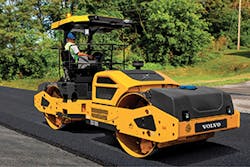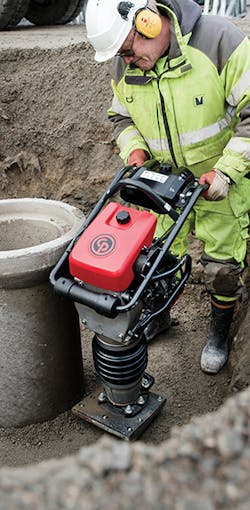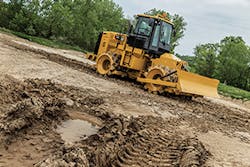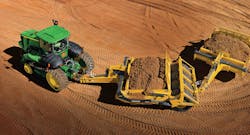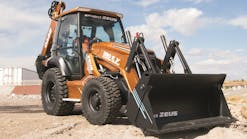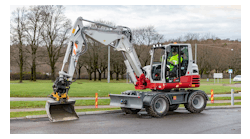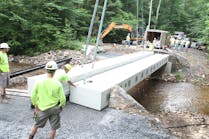You don’t have to sell the Oregon Department of Transportation on the benefits of intelligent compaction. The department has already made a forceful argument that technology-guided roadway compaction can save money, allow construction crews to finish roadway projects in less time, and result in highways that last longer before they need repairs.
The Oregon Department of Transportation made its argument for investing in intelligent compaction technologies during an annual project meeting in January of 2015.
During their presentation, department officials said that GPS-based compaction systems provide real-time coverage information to operators; accurately monitor, display, and record the mat temperature for rollers and pavers on entire projects; automatically collect and record data that transportation officials can then analyze later; and verify the pass counts, mat temperatures, and roller speeds of compactors working on roadway projects.
In short, department officials made their claim that the benefits of using intelligent machine control technology with compactors far outweigh the costs of investing in this technology in the first place.
Fortunately, officials with the Oregon Department of Transportation aren’t alone in this assessment. The manufacturers of compactors are arming their machines with GPS-based technology that can help operators hit their required soil-density levels in less time. They are also adding technology that makes it easier for even new operators to run compactors efficiently and safely.
Most importantly, the technology revolution hitting the compactor industry—a piece of construction equipment that is not always front of mind when contractors are considering high-tech upgrades to their job-site vehicles and machines—is just getting started, according to the makers of compactors.
Combine these tech advancements with the long-standing versatility of compactors and it’s easy to understand why these machines, often taken for granted by busy contractors, are such an important tool on grading and excavation job sites today.
The Chicago Pneumatic MS695 works in close quarters.
Versatility Matters
The big selling point of compactors has long been their versatility. Contractors can use them for a variety of jobs. This, of course, can help contractors save money and boost their bottom lines.
The versatile compactor family includes rammers, double-drum rollers and trench rollers. Each of these machines can take on a large number of jobs, everything from small repairs and road maintenance work to trench compaction and foundation work. Contractors rely on compactors to handle sidewalk and parking lot fixes, too.
Darrell Engle, product manager for light compaction and concrete at Chicago Pneumatic Construction Equipment, says that the key is for contractors to use the right machine for each job.
Contractors who do this will quickly find that compactors are an essential part of any job site.
Compactors come in a variety of sizes. There are the heavy rollers that compact large swaths of materials on roadway projects. But other companies sell smaller, lighter-weight compactors that operators either ride on or push while they are standing behind them.
These smaller compactors play important roles on job sites, allowing operators to compact soil in difficult-to-reach areas, and illustrate just how versatile these construction tools can be.
“These products are small compared to the large rollers that you would normally see on a site,” explains Engle. “This allows these products to work in small or confined spaces as well as corners. This makes these products essential because they complement the rollers on the site and can compact in places the roller will not reach.”
Katie Pullen, brand marketing manager with CASE Construction Equipment, says that this versatility will always keep compactors in demand.
Pullen illustrates the versatility of compactors by pointing out the many jobs different kinds of these machines can handle. Single-drum compactors, for instance, are designed for efficient soil compaction, and contractors can use them on multiple surfaces with either a smooth drum or a pad-foot. Contractors can also equip these same machines with leveling blades to knock down large clumps of dirt before they start compacting materials.
Double-drum compactors with smooth drum rollers are typically used for asphalt and granular materials like sand or gravel compaction, while pneumatic tire compactors can be used for a variety of hot-mix asphalt projects, surface treatments, and soil-stabilization applications.
This versatility does mean that contractors have to do their research before sending their compactors out on a job. They want to make sure that each compactor they send out is handling a job that best fits its particular specifications.
“There is a suitable machine for virtually any type of compaction application, so it’s important for contractors to understand the many variables that determine the right roller for each compaction job,” says Pullen.
The first thing for contractors to consider? Whether they are compacting soil or asphalt. Contractors need, too, to consider the width of the area in which they are working, the final density required, the grade of the area that is being compacted and the type of asphalt mix and soil type of a work area.
The type of soils being compacted play an important role in deciding which compactors are best suited for a job, Pullen said. More granular materials such as sand and gravel typically require a smooth drum or a pneumatic roller. The smooth surfaces of these compactors, along with optimal moisture levels in the soil, allow granular materials to consolidate more efficiently. A vibratory compactor will allow for deeper compaction depths than will a pneumatic roller, Pullen said.
Contractors working with more cohesive materials, such as clay, should use a vibratory pad-foot drum. That’s because cohesive soils tend to stick together and slip over each other during compaction. For these types of soils, it is important to shear the soil with the pad-foot drum to achieve the ideal compaction density.
The key is for contractors to have a plan when it comes to compaction, Pullen says.
According to Pullen, “Compaction is an essential part of the grading and excavating process because it is the component of the process that provides stabilization for the rest of the project. Without proper compaction, a job will fail in the future.”
A Growing List of Duties
Tom Griffith, senior system application specialist for Caterpillar, provides his own list of jobs that compactors can perform for contractors hired to move dirt and build roads.
Operators armed with compactors can level fill materials, hit the final density for the roads that they are building and work fill in tandem with articulated trucks, dump trucks, and scrapers.
Construction crews also rely on compactors to mix soils and materials until they reach the correct moisture and density, Griffith said. Compactors can even pull certain lighter-weight mixing tools and take on minor excavation work when dozers are not available to perform these two jobs.
This Swiss-army-knife versatility makes compactors a particularly important tool, Griffith says.
“From the operational perspective, compactors’ main priorities are the high-speed operations of dozing, filling and compacting,” says Griffith. “Their design enables them to produce and compact at a higher rate than any other machine. From the start of the project to the end, the customer makes money by getting the job done right the first time with high production and compaction.”
Compactors are essential to contractors because they can push, level, layer, grade and compact large loads. They are also stable and easy to maneuver, making them one of the least-challenging tools for even newer operators to handle.
The compactor itself is a marvel of design. Griffith points to the wheels of these machines as an example. These wheels are designed for traction and penetration, which enables higher densities and production. Rear drums track the front drums on compactors, giving these machines more compacting power.
“Contractors want and need quick, high densities and production,” points out Griffith.
New Technology
As with most manufacturers today, the makers of compactors are boosting their technology. This is resulting in a steady stream of tech advancements that are making it easier for construction crews to efficiently operate their compactors.
According to Engle, the two most important tech advancements in the compactor industry are compaction indicators and low-vibration handles.
Compaction indicators help remove the guesswork from when a specific material has reached its level of full compaction. With this tool, operators no longer run the risk of over-compacting material after it has reached its optimal compaction level. This, of course, saves both time and money for a contractor.
Low-vibration handles are another bonus for operators. Because they mute the force of the vibrations emitted from compactors, they place far less strain on operators. This means that operators can work compactors for longer hours with less fatigue.
“I believe that contractors are embracing the new technology,” says Engle. “They understand the benefits of increased production with minimal downtime. Some of the technology even helps their fatigue level, like the low-vibration handle.”
Compactors are rarely the first pieces of construction equipment that contractors think of when they are considering technology that can help them work more efficiently. Compactors, after all, already seem fairly simple to operate. What tech could change that?
But Pullen maintains the same kind of intelligent machine control technologies hitting other construction vehicles are also making an impact in the compacting field.
“Compaction equipment is about as straightforward as it gets, but there is a science to it,” she says. “Intelligent compaction technologies help simplify operation and allow contractors to improve productivity by getting work done right the first time.”
What is intelligent compaction? Just about anything that contractors can rely on anything from a standard compaction meter to full machine control technology to help them hit their ideal soil densities in less time.
Basic compaction meters can help in this task, but are limited. These tools measure only how much rebound there is on a drum. Full machine-control systems, though, use GPS technology to map out the number of passes and compaction stiffness readings of an entire job site. Compactors equipped with this technology will also adjust the amplitudes and frequencies to the rebound of the drum without operator input. The only thing, then, that the operator needs to worry about is a compactor’s operating speed.
“One of the biggest trends driving the use of intelligent compaction is the verification that the total job site meets compaction requirements,” explains Pullen. “Intelligent compaction gives operators the ability to target exact areas that have issues, and it helps to take the operator error out of the operation. Intelligent compaction also provides less invasive testing techniques as it becomes more accepted.”
With intelligent compaction technology, contractors can install a newer operator on a compactor without worrying as much that this new crewmember will struggle to hit the correct density on a job site.
This doesn’t mean, though, that contractors can skimp on training. Even with intelligent compaction, contractors still need to train their operators on how to correctly control their compactors.
“While these systems are getting more intelligent, the human factor is still critical,” adds Pullen. “Simplified training helps bring those operators up to speed.”
Caterpillar, of course, is adding new tech to its line of compactors, too. The company has partnered with positioning-technology company Trimble to add laser and GPS technologies to its compactors.
This has made it easier for operators to hit proper levels of soil density in less time. CAT Compaction Control is factory-installed with its compactors. Operators can set it the control to a specific soil density or stiffness. This way, the machines’ operators automatically know when they achieve the proper densities.
The Cat 815K Soil Compactor at work
Those contractors who add the optional 3D mapping system offered by Caterpillar can make their operators even more efficient. With this technology, operators can not only achieve better density, they’ll also do it while staying more uniform throughout their work areas.
“Layer depth, slopes, and final grade can all be added to the 3D plan to help the operator be productive and efficient,” says Griffith. “The system enables not only the operator but also site supervisors and engineers to understand the density and materials compaction measurements to a precise location or area. From the operator standpoint, it means less work with less stress.”
Caterpillar compactors, like all of the company’s machines, can also be equipped with LINK technology. This tech keeps contractors in constant contact with their machines and their entire fleet. By accessing the data provided by the LINK system, contractors can analyze how much fuel their compactors have burnt during a recent job, their location at any time and event codes.
Armed with this information, contractors can schedule maintenance at the proper times, give advice to an operator who isn’t running a compactor as efficiently as possible and catch possible problems with a machine before they become more expensive fixes.
“Location, fuel, machine utilization, and event codes are just a few of the parameters that the customer can monitor to help make real-time, cost-effective decisions,” concludes Griffith.
Mark Eckert, global product manager for Volvo Construction Equipment, says that manufacturers today are constantly boosting the safety and comfort levels of operators.
Much of these improvements stem from the enhanced cabs that protect the drivers of compactors.
The cabs of today’s newer compactors shield operators from excessive noise from their machines. The cabs also do a better job of muffling the vibrations from compactors, giving operators a more comfortable ride. The seats inside cabs are easier to adjust, while the cabs’ windows provide greater visibility for operators. At the same time, the control levers of compactors are laid out in a more intuitive fashion, making it easier for drivers to operate them.
“It’s all about making a more comfortable environment for operators,” says Eckert. “That is where the industry is moving today. We are seeing more cab units sold in North America than ever before. In Europe we sell most every compactor with a cab. In North America, it’s rise, but it’s still only about one in four. We are seeing that tick up a bit as contractors are seeing the value in having a compactor with a cab. They are seeing the value in making their operators more comfortable.”
Of course, it costs contractors less to purchase an open compactor without a cab. But a growing number of contractors are spending the extra dollars for cab compactors because, as Eckert says, they understand that operators who are more comfortable are usually more efficient, too.
Impact spacing meters are also helping to make operators more efficient, too. These gauges show operators how many impacts they make per foot, helping operators determine if they are driving too quickly or too slowly.
But the real advancement in compactor technology? Like others, Eckert points to intelligent compaction technologies. Installing GPS technology in compactors is doing more than any other tech to improve the performance of operators.
“The data can be taken from those units to show operators exactly how efficient they were,” continues Eckert. “They can see exactly how many passes they did. They can see how long their runs were. They can see everything.”
The good news is that contractors are not only using the new technology that comes with compactors, they are embracing it.
The reason for this is obvious: Contractors understand that improving technology makes it easier for them to get their jobs done on time and under budget. That helps them retain customers from one bid to the next, and makes hitting their yearly revenue and profit goals an easier task.
“Speaking as an operator, time and motion are a detriment as they increase,” attests Griffith. “Contractors are able to bid jobs more effectively and understand exactly what it will take to start, maintain and finish the job with the new technologies available today. Production stays higher, while time, fuel and maintenance stays lower, allowing them to meet end dates at a lower cost.”
It comes down to a long-held truth that Griffith likes to quote: It’s better to work smarter and more efficiently than it is to work harder.
“The old adage of working smarter, not harder is very true in competing with job bids,” he said. “Embracing technology allows contractors to lower costs in all realms of machine operation.”
Keeping Compactors Healthy
What steps can contractors take to make sure that their compactors spend more time on the site and less in the repair shop? It’s fairly simple: Contractors need to follow the maintenance guidelines outlined by the manufacturer.
The challenge comes when contractors don’t bother to follow these maintenance guidelines. And, unfortunately, this isn’t rare. Many contractors are so busy that they skimp on the preventive maintenance that is recommended for all their machines.
And when it comes to some of the smallest machines on a job site—compactors—it’s even more likely that contractors when pressed for time will skip the daily checks and maintenance procedures that help prolong the lifespans of compactors.
“It is common that these machines get the least amount of attention in the equipment lineup when it comes to maintenance,” says Engle. “However, a good maintenance program will keep the equipment safe to operate, and will keep downtime to a minimum.”
Debris in the water system is one of the most common maintenance concerns for asphalt rollers. This can cause nozzles to get clogged and pumps to fail. Any components that circulate water can break down, thanks to debris.
Unfortunately, many operators bring this common problem on themselves. “The initial filtration for rollers is at the fill point. A lot of people remove that screen at the fill point and never replace it because it slows down the rate at which you can fill the water tank,” says Pullen. “That’s a bad idea. You want to filter the water before it ever enters the tank, and this filter is the first and best line of defense.”
After that key filter, most compactors come with only one more filtration point that can stop debris before it gets to the pump. Because compactors are often working in dusty environments, these machines are at high risk of having debris enter their water tanks. It’s up to contractors and operators to take every step possible to prevent this from happening.
If debris does enter the water tank, the water flow to the pump will be sluggish, even when a compactor is turned up to the highest pressure setting. That’s because water is getting clogged in the mid-filter before it goes to the pump. If debris gets past that mid-filter, the pump itself could become compromised and fail. And if debris reaches all the way to the nozzle heads, they, too, will become clogged, Pullen said. There then might not be enough water to create the steam barrier to properly compact asphalt. This could in turn result in hot asphalt that sticks to the drums of working compactors.
“You want to keep your initial filter screen on and clean,” warns Pullen, “You want to check your filters on a regular basis. The sprinkler-bar nozzle usually requires no tools to remove to check, so you want to check those periodically and make sure that there is no debris present there.”
Contractors also need to make sure that the drums of their compactors are clean and undamaged. Operators running a single-drum vibratory roller need to check that their machines aren’t experiencing any problems with their tires. They should check frequently, too, that their compactors’ tires are inflated to the recommended pressure.
Savvy contractors don’t view daily maintenance as a chore to be avoided. Instead, they consider it a step toward keeping their machines operating properly for as long as possible.
Smart contractors also understand how important it is to require that operators perform daily walk-arounds of their compactors as a way to uncover possible problems with these valuable machines.
“It all starts with how operators view maintenance and machine operation and productivity,” explains Griffith. “The smart customer will understand that operators must perform daily walk-arounds and pre-shift inspections, even though maintenance people might have performed fueling and greasing. A second set of eyes will always help catch machine concerns earlier.”
Contractors who want to keep their compactors in the field and out of repairs will also adhere to a regular maintenance and preventive maintenance schedule, one that they won’t deviate from even as other company issues attempt to distract them.
Griffith adds, “The mentality that they must schedule and track scheduled maintenance and preventive maintenance as required for their equipment will help them keep their fleet operational with a minimum of downtime and maximum availability.”